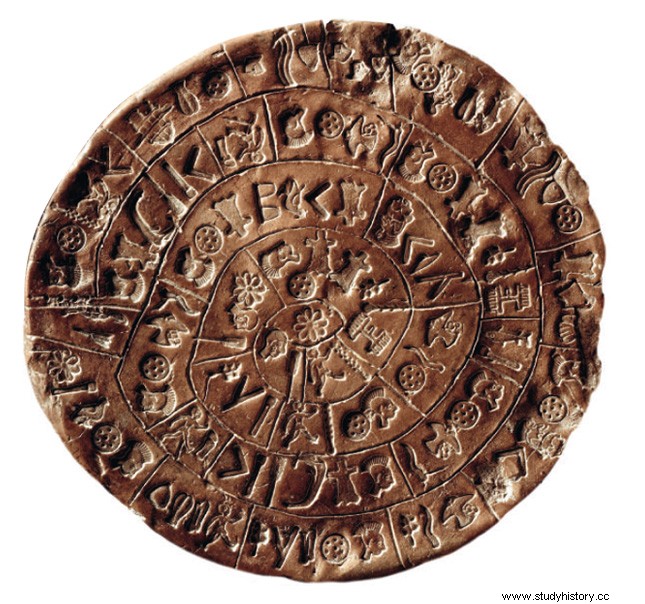 Phaistos disc discovered in Crete (1700 BC).
Phaistos disc discovered in Crete (1700 BC). GODDESS. The enigmatic Phaistos disc, this strange clay disc 16.5 cm in diameter and 1 cm thick dated to 1700 BCE and preserved in the Archeology Museum of Heraklion (Crete), may come to reveal one of his last secrets. One of the key characters revealed by the text could indeed relate to the Minoan goddess Astarte, according to Gareth Owens, linguist and coordinator of the Erasmus program at the Technological Education Institute (TEI) in Heraklion. Or the mother goddess of the Minoan culture. Which would make the Phaistos disc a religious hymn. To achieve this result, the scientist proceeded by analogies based on epigraphic studies devoted to ancient Cretan scripts (see box):Linear A of the Minoans (appeared around 1800 BC) and Linear B of the Mycenaeans ( 1375 BC), deciphered in 1952 by the Briton Michael Ventris, based on the work of Alice Kober.
There is no doubt that we are talking about a religious text" , said Gareth Owens.
The researcher thus confirms a hypothesis that he had already put forward with his colleague John Coleman, professor of phonetics at Oxford (United Kingdom) in October 2014. The two researchers had indeed managed to "read" I-QE- KU-RJA three timess on the disc, which they had then translated as "pregnant woman and/or pregnant Goddess", I-QE being able to mean "mother" or "goddess".
Now, Gareth Owens has decided. He thinks that the Phaistos disc evokes on one side a pregnant mother goddess and on the other, the Minoan deity Astarte. With this discovery, it is perhaps one of the last mysteries of this clay disk which is on the way to being solved, this one having resisted for more than a century - since its discovery in 1908 - any decryption. of these 241 enigmatic inscriptions before Gareth Owens and John Coleman apparently succeeded in transcribing 90% of them.
Both sides of the disc bear 241 signs. There are 45 different symbols, arranged in 61 sequences of 2 to 7 signs. © Luisa Ricciarini/Leemage

Cretan writing
During the Bronze Age (3000-1200 BC), two civilizations flourished in Greece:the Minoans on Crete, and the Mycenaeans on the mainland. We owe the archaeologist Sir Arthur John Evans (1851-1941), to have discovered in the island of Crete, at the dawn of the 20
e
century, not one script, but three:Linear A, Linear B, and Hieroglyphic. We know today that only Linear A and hieroglyphics were used by the Minoans, while Linear B was of Mycenaean origin and transcribed the Greek language. Linear A, a syllabic script, is still not deciphered. Too few tablets bearing this writing having been discovered to date.
